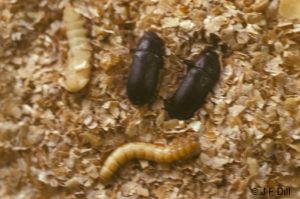Mealworms
Pest Management Fact Sheet #5044
James F. Dill, Pest Management Specialist
Clay A. Kirby, Insect Diagnostician
For information about UMaine Extension programs and resources, visit extension.umaine.edu.
Find more of our publications and books at extension.umaine.edu/publications/.
Description & Biology
The mealworm larva is yellowish to brown with a smooth, shiny, worm-like body. It is about 1/8″ thick and is usually 1 to 1¼” long when mature and ready to pupate. The emerging adult (beetle) is black and about 3/4″ long. After mating, the female can lay up to 1,000 eggs which hatch in about 18 days. The newly hatched larva takes six to nine months to mature. The complete life cycle (egg to egg) usually spans more than a year; however, under ideal conditions it can be completed in as little as four months.
- Mealworm larva and adult
Mealworms can be found in moist grain in dark and undisturbed areas. The normal operations of feed grain systems would not suit them, but waste, dusty, or damp areas create a favorable haven. Although they feed on cereal products used in homes, such an environment ordinarily would not meet the insect’s needs.
Mealworm outbreaks usually occur where grains are processed and stored. Litter remaining in old or abandoned poultry houses appeals to these insects, and explosive populations have created severe problems for residents within a half-mile of the source of an infestation.
Management
Good management through early detection is important. Keep food in a tightly covered container and clean containers frequently. Do not overlook dry dog or cat foods, either, or areas around their food dishes where the crumbs can accumulate.
Infested grain must be removed from storage and disposed of or used. Before it can be used, the grain must be treated with insecticide. Waste products must also be treated, unless they are buried in a sanitary landfill. Infested poultry litter must be handled the same way, unless it is spread over the ground and plowed under. Poultry litter simply dumped outside on the ground can become infested by beetles living in the area. Contact the Pest Management Unit for recommendations on treating large quantities.
Those bothered by mealworms should remember never to discard infested food without first killing the insects. This is best done by placing the infested food in a container and heating it in an oven at 130° F to 150 °F for 30 minutes. Then discard the food. Placing infested food in a freezer for five days or so should also kill the insect in all stages of its development. A vacuum cleaner can be an effective tool as well. Discard the vacuum cleaner bag or contents into a sealed plastic bag to help prevent the infestation from spreading. A household aerosol insecticide can be used inside the home, but the results may be spotty because other mealworm beetles may come in from outdoors.
Adult mealworms outdoors must be controlled at the source. If mealworm adults are a continuing problem, an insecticide labeled for perimeter treatment may provide a protective barrier around the home. Sprinkle enough water on the treated area to wash the insecticide off the grass and onto the ground where the beetles commonly hide during the daytime. These nocturnal insects will also fly to lights and crash into the house, which knocks them down and deposits many of them into the sprayed (perimeter) area. This should give them enough of an exposure to the insecticide to kill them before they happen to find their way into the house.
Keep in mind that these beetles will not vanish overnight and another application of insecticide may be necessary after a rain or within a week or so of the first application.
When Using Pesticides
ALWAYS FOLLOW LABEL DIRECTIONS!
Pest Management Unit
Cooperative Extension Diagnostic and Research Laboratory
17 Godfrey Drive, Orono, ME 04473
1.800.287.0279 (in Maine)
Information in this publication is provided purely for educational purposes. No responsibility is assumed for any problems associated with the use of products or services mentioned. No endorsement of products or companies is intended, nor is criticism of unnamed products or companies implied.
© 2016, 2018, 2020 | Reviewed & Revised: 2023
Call 800.287.0274 (in Maine), or 207.581.3188, for information on publications and program offerings from University of Maine Cooperative Extension, or visit extension.umaine.edu.
In complying with the letter and spirit of applicable laws and pursuing its own goals of diversity, the University of Maine System does not discriminate on the grounds of race, color, religion, sex, sexual orientation, transgender status, gender, gender identity or expression, ethnicity, national origin, citizenship status, familial status, ancestry, age, disability physical or mental, genetic information, or veterans or military status in employment, education, and all other programs and activities. The University provides reasonable accommodations to qualified individuals with disabilities upon request. The following person has been designated to handle inquiries regarding non-discrimination policies: Director of Equal Opportunity, 101 Boudreau Hall, University of Maine, Orono, ME 04469-5754, 207.581.1226, TTY 711 (Maine Relay System).



